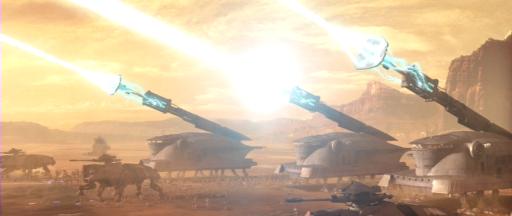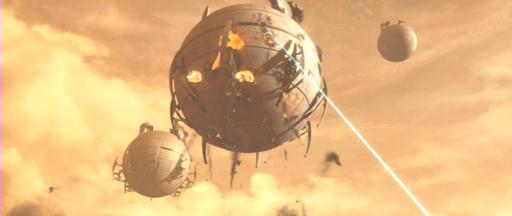Star Wars Artillery
The role of artillery in Star Wars is similar to the role of artillery in real life, with mortars for close and medium range infantry support, and field artillery for long-range strikes. However, the Empire's reliance on what most sci-fi fans refer to as "energy weapons" hampers their effectiveness. Real-life artillery relied on a line of sight to the target a couple of centuries ago, but the advent of modern fire control techniques as well as high-speed computers means that an artillery piece can very quickly calculate the elevation and charge required to lob a shell into the air so that it will fall back down upon the target. This means that it isn't necessary to have a clear line of sight, which can extend their range past geographical obstructions or even the horizon. However, the "energy weapons" used almost universally throughout sci-fi require a direct line of sight, which actually makes them inferior in many respects to a modern artillery piece.
However, it is noteworthy that the two self-propelled guns known to exist are both heavily armoured and shielded repulsorlift platforms, which obviously use altitude in order to compensate for the limitations of "line of sight" targeting. This still leaves the problem of their vulnerability, since a repulsorlift-based self-propelled line of sight gun will be more open to attack than a conventional artillery piece. However, this is arguably one of the areas in which the futuristic technology of Star Wars imbalances some basic tactical axioms: an aircraft cannot normally be heavily armoured, but a repulsorlift aircraft seems to be capable of at least partially overcoming this weakness. Nevertheless, the size and speed of an Imperial self-propelled gun still means that its best chance for survival is to use its long range to attack vehicles or troops that cannot fire back.
Mortars
We didn't see any mortars in the canon films, but the SWEGWT provided us with a look at the Merr-Sonn MobileMortar-3. Like real-life mortars, it launches explosive projectiles at high firing angles in order to bombard artillery at short to medium range (maximum 1 kilometre). Its magazine carries 12 C-22 frag grenades, with an optional ammo pack which increases its capacity to 100 grenades. It can be fitted to a mobile platform (the WW-676 repulsorlift platform), again just like real-life mortars, which are sometimes fitted to vehicles. The platform's repulsorlift propulsion system gives it superior mobility when compared to any real-life ground vehicle, with a maximum airspeed of 250 km/h and a maximum altitude of 30 metres. This speed and versatility allow the operator to "shoot and scoot", by launching a short barrage of grenades and then immediately racing away before enemy counter-battery gunfire or artillery can retaliate. The WW-676 repulsorlift platform also augments the ammunition capacity of the mortar, with a storage bay that carries up to 500 extra grenades.
Unfortunately, this is a self-propelled mortar rather than an armoured vehicle, so there is no protection whatsoever for the operators. However, it is possible to equip WW-676 repulsorlift platforms with heavy automatic weapons such as E-Webs for defense, which would be analogous to real-life vehicles such as the Land Rover Defender SOV (special operations vehicle). The Defender is a light wheeled vehicle (it looks like an overgrown jeep) which has a reinforced bonnet on which an 82mm mortar can be mounted, and which can carry 7.62mm and 12.7mm machine guns for defense.
The tactics of Imperial mortar use are undoubtedly similar to those in real life, with the notable exception that chemical and biological weapons can be used even at short ranges, thanks to the NBC (nuclear, biological, chemical) protection offered by the stormtrooper uniform.
Towed Guns
 Imperial
artillery pieces are rarely seen in the canon films, but the Hoth
battle provided a look at two such pieces, albeit low-end pieces
which proved to be inadequate against the Empire's AT-AT walkers. The
first was the Golan Arms DF9 (at right) and the Atgar P-Tower (click
here to see it). Both pieces appear to be
immobile powered turrets, although the Rebels were able to quickly
deploy them to the engagement area, so there is presumably some
method of moving them (most likely a small repulsorlift units which
can be bolted to the unit so that it can be towed around). Therefore,
although they are both visually quite different from real artillery
pieces, they appear to fall into the category of towed guns.
Imperial
artillery pieces are rarely seen in the canon films, but the Hoth
battle provided a look at two such pieces, albeit low-end pieces
which proved to be inadequate against the Empire's AT-AT walkers. The
first was the Golan Arms DF9 (at right) and the Atgar P-Tower (click
here to see it). Both pieces appear to be
immobile powered turrets, although the Rebels were able to quickly
deploy them to the engagement area, so there is presumably some
method of moving them (most likely a small repulsorlift units which
can be bolted to the unit so that it can be towed around). Therefore,
although they are both visually quite different from real artillery
pieces, they appear to fall into the category of towed guns.
Their effectiveness is difficult to establish: while the AT-ATs easily shrugged off P-Tower fire (even direct hits on their knee joints), the AT-STs were nowhere to be seen at the end of the battle, and it seems likely that they were all destroyed. The DF9 and P-Tower were much different in appearance: the DF9 is a powered turret which looks remarkably like a real light cannon, similar to the 25mm gun that might be found on a modern APC. The P-Tower, on the other hand, looks rather like a large dish antenna, and when it fires, the central gun seems to draw energy from the rest of the dish. The dissimilar operating mechanisms suggest dissimilar firing characteristics, and the official literature supports this interpretation by classifying the DF9 as an anti-infantry piece and the P-Tower as an anti-armour piece.
The SWEGWT also elaborates somewhat on their capabilities: the DF9 is said to have a range of 16km with a minimum 3 seconds between shots, and it is lightly armoured and shielded, although obviously not well enough to survive AT-AT fire, as DF9s were easily destroyed in the Battle of Hoth. Its shots are said to function like a real-life proximity-fused airburst projectile, scattering over a wide area for maximum anti-personnel effect. The P-Tower's range is somewhat lower (10km instead of 16km) and it has a longer refire delay of 10 seconds. It was seen firing on the AT-AT walkers in the Battle of Hoth (with no effect), but its bolts do not have any sort of airburst or "flak" effect, and they are said to be capable of penetrating the armour of lighter vehicles (a category which presumably includes the AT-STs that accompanied the AT-ATs in the Batle of Hoth and which did not appear to survive).
Of course, these two guns aren't the only towed artillery pieces in the Empire. The SWEGWT mentions the "massive CoMar G-003 Tri-Tracker unit" as a much more expensive and capable anti-verhicle artillery piece than the P-Tower but unfortunately, it provides no illustrations or details.
Self-propelled Guns

Republic
SPHA-Ts firing during the Battle of Geonosis
A
TradeFed core ship being destroyed by SPHA-T fire
The most well-known self-propelled gun in the canon films is the SPHA-T (self-propelled heavy artillery turbolaser) in AOTC. This is a truly massive unit, as you can see from its cockpit scale (the gun is more than 40 metres long). Please note that contrary to popular belief, the core ships' shielding was active in the scene shown above, as ITW:AOTC states clearly that they were "self-shielded" at time of lift-off (although we don't know how their shielding compares to the shielding of the entire ship). It also states that 100 of these units were deployed at Geonosis.
While it is tempting to exaggerate the usefulness of these platforms (some have even argued that they are more powerful than heavy starship weapons, thus begging the question of why they wouldn't just bolt them onto starship hulls), it must be noted that it lacks a starship's power generation capabilities. ITW:AOTC states clearly that "the SPHA-Ts can only be charged up to a certain level; after these shots, they must be replaced with charged guns from the rear lines", which means that the units which brought down one of the core ships probably spent their ammunition in the process.
It should be noted that the SPHA-T is not the only model of this artillery platform. There is also an SPHA-I which fires ion cannon blasts, and it is possible that other models exist as well. This clip (courtesy of Brian Young) from the Clone Wars cartoon depicts a model which fires a round with very noticeable gravity arcing.
The official literature also describes airborne artillery, in the form of the MAS-2xB Self-propelled Turbolaser. According to the SWEGWT, it is a self-propelled turbolaser which was designed for use as a siege weapon, to blast through heavy fortifications. The MAS-2xB is an enormous repulsorlift vehicle that is over twice the size of an Imperial walker, with massive 2m thick armour and multiple shield generators. It carries two turbolaser turrets and a quad-laser turret to defend it from attacks, and its primary weapon is a large turbolaser that has a maximum range of 30km (which is quite similar to the range of a real-life self-propelled artillery piece). Its energy output is said to match the output of one of a Star Destroyer's light turbolaser cannons, so it can easily blast through armour as thick as 20 metres. A turbolaser bolt wouldn't encounter that much armour if it blasted through one side of a Federation starship and out the other, so this gives us some idea of the power of light capital ship turbolasers. It also gives us some idea of the strength of capital ship shields, which can easily absorb hundreds of such blasts.
Naval guns in a ground-based weapon are highly unusual, and would be analogous to the huge "rail guns" that were deployed in Europe during WW2. The principal drawback is cost and poor mobility (the original rail guns suffered from the same drawbacks). The MAS-2xB's speed is inferior to that of an AT-AT walker, never mind the horde of light repulsorcraft or war droids that its enormous price tag could easily buy. The same is true of the SPHA-T. It is only used when extremely high firepower is required, without resorting to orbital bombardments which reduce the entire area to slag.
Yet another self-propelled gun in the official literature is mentioned in the SWE, which mentions the Imperial "Floating Fortress". It is described as a cylindrical repulsorlift vehicle which is specialized for urban pacification rather than attacks on hardened targets. It carries twin-turret heavy blaster cannons, heavy armour, and sophisticated surveillance and targeting systems that can easily track and target multiple simultaneous targets from a single command centre. It carries a crew of four, and has enough cargo capacity to carry ten troopers, thus giving it the dual role of self-propelled gun and APC, although the cargo carrying role is clearly secondary. Unfortunately, the SWE does not elaborate on its range.
And finally, as in real life, some self-propelled guns are simply towed guns mounted to a makeshift vehicle platform. The SP9, for example, is a DF9 anti-personel towed artillery piece which has been fitted to a dedicated repulsorlift sled, which has a maximum speed of 60 km/h.
Rocket Artillery
The Empire does not appear to use rocket artillery. There are no records anywhere of this type of weapon in the Imperial arsenal, perhaps because of its limited accuracy. The Hailfire missile-firing battle droid could be confused for rocket artillery, but it fires guided missiles, and is a direct combat vehicle rather than an area-effect weapons platform like an MLRS.